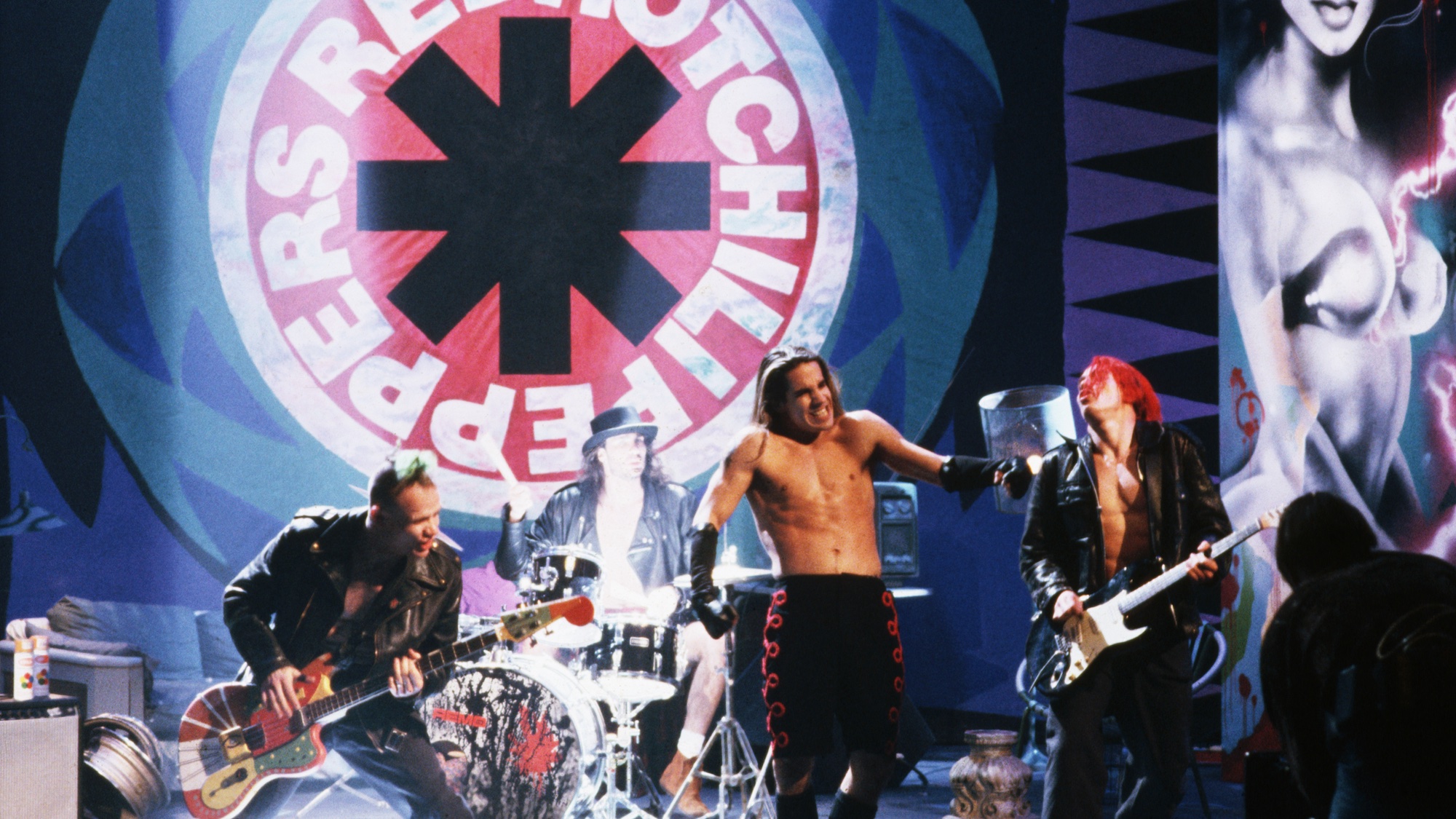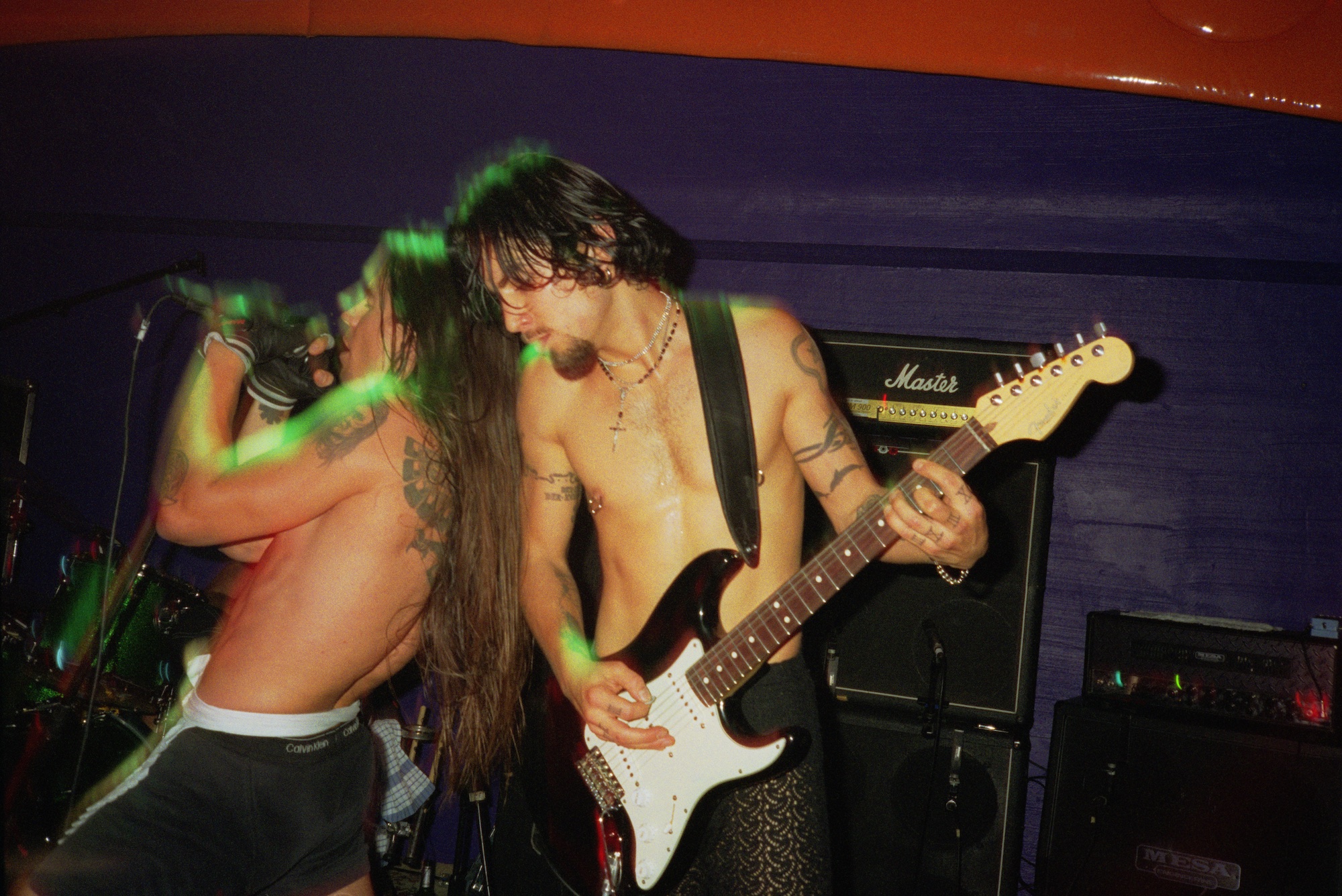John Frusciante and Dave Navarro are the household names, but plenty more guitarists made their mark with the Red Hot Chili Peppers. Here’s our guide to all of them
RHCP founder Hillel Slovak created the template, but the seven guitarists who later enjoyed stints in the band all created their own delicate balance of funk grooves and rock aggression

The late 80s saw a brief explosion of funk-rock. While the Red Hot Chili Peppers are clearly the Beatles of that period of funk-rock in hindsight, the funk-rock invasion saw them initially competing with the likes of Jane’s Addiction, Faith No More, Primus, Living Colour, and 24-7 Spyz.
From that fertile scene came guitarists who combined Hendrix’s chord-melody approach with P-Funk syncopation and Zeppelin-level riffage. RHCP founder Hillel Slovak created the template, but the seven guitarists who later enjoyed stints in the band all created their own delicate balance of funk grooves and rock aggression.
Here’s a rundown of all eight players, and the other places you might find them.
Hillel Slovak – (1982–1983, 1985–1988)

The Chili Peppers’ founding guitarist left an indelible mark on rock history despite recording only two full albums with the band.
Slovak co-wrote five songs on the band’s 1984 self-titled debut, but left before its recording to focus on his other band, What Is This?, who had signed to MCA Records. After an EP and an album, Slovak asked to return to RHCP, prompting vocalist Anthony Kiedis to tell Flea, “I'd give my firstborn son to get him back in the band.”
I learned everything I needed to know about how to sound good with Flea by studying Hillel's playing, and I just took it sideways from there
John Frusciante
Slovak’s influence loomed the largest on a young John Frusciante. He was best known for playing a rosewood-board Strat into a cranked Marshall (a 100 watt Superbass), for a style that was equal parts Hendrix and funk, and for his signature use of fuzz and wah – all elements that Frusciante would make his own trademarks.
Frusciante didn’t even play funk before studying Slovak’s style.
All the latest guitar news, interviews, lessons, reviews, deals and more, direct to your inbox!
“I learned everything I needed to know about how to sound good with Flea by studying Hillel's playing, and I just took it sideways from there,” he told Guitar Player in 1997.
Slovak’s tragic death by heroin overdose in 1988, aged just 26, cast a long shadow over the band’s history. Multiple RHCP songs have been written in his honor, and when the band were inducted into the Rock & Roll Hall of Fame in 2012, Slovak was included.
“He's a beautiful person that picked up a guitar in the 1970s and didn't make it out of the 1980s, and he is getting honored for his beauty,” Kiedis said at the time.
Jack Sherman – (1983–1985)
When Hillel Slovak ditched the Chilis in 1983, Jack Sherman filled the position. He would go on to feature on the band’s self-titled debut album.
Bassist Flea later wrote on social media that Sherman had “played the most wicked guitar part on our song Mommy Where’s Daddy, a thing that influenced the way I heard rhythm forever.”
Although he was fired before the recording of Freaky Styley (1985), seven of the songs he co-wrote still made the album.
Post-Chilis, Sherman recorded with Bob Dylan, Parliament/Funkadelic founder George Clinton, and ex-Undertones frontman Feargal Sharkey. He died of a heart attack in 2020, aged 64.
DeWayne “Blackbyrd” McKnight – (1988)

After Slovak’s death, the Chili Peppers needed an emergency replacement, a role that would be filled by Parliament/Funkadelic guitarist DeWayne “Blackbyrd” McKnight. It further solidified the band’s authentic funk credentials, with P-Funk leader George Clinton having produced Freaky Styley.
McKnight didn’t exactly slot into the band smoothly, however, and they fired him three dates into the next tour. The guitarist was reportedly so unhappy that he threatened to burn down Anthony Kiedis’ house.
McKnight later revealed to Guitar World that he had been asked to fill-in for Slovak multiple times before his death, but each time Slovak came back in time to do the show.
“You might even say that they had gotten me in there to coax Hillel back; at least that's how I saw it. But I don't know how it went, and I don't know what they felt because I never talked about that with them.”
Outside of RHCP and P-Funk, McKnight also has credits with jazz legends Herbie Hancock and Miles Davis, as well as with the fusion band, The Headhunters.
John Frusciante – (1988–1992, 1998–2009, 2019–present)

Despite Hillel Slovak’s immense influence on the band, John Frusciante is for most the defining RHCP guitarist. He has twice left the band, and each time his return has brought a huge boost to the band’s creative and commercial fortunes.
His 1998 reunion with the band produced the 15-million-selling Californication, while his 2022 comeback with the band, Unlimited Love, shot to #1 in the US and ten other countries, a feat that the band had not achieved since before his departure.
But it was 1991's Blood Sugar Sex Magik, the band’s commercial breakthrough, that really secured Frusciante’s place in the guitar pantheon. Frusciante may have been following Slovak’s blueprint, but he made it convincingly his own.
On Under the Bridge, Frusciante appropriated Hendrix’s combined rhythm-and-lead style more convincingly than anyone since Jimi himself, while thumpers like Give It Away and Suck My Kiss had punk levels of aggression without the need for heavily distorted tones. While many bands in the funk-rock explosion sacrificed the funk element to sound heavier, Frusciante didn’t compromise on either.
The success was too much for Frusciante, who became a recluse and developed a heroin addiction. He managed a pair of twisted and experimental solo albums before reuniting with the band to power them to even greater success. He also found time for a side project, Ataxia, with Fugazi bassist Joe Lally and future RHCP guitarist Josh Klinghoffer.
The 2000s were a prolific decade for Frusciante, who released eight solo albums and juggled multiple side projects, as well as releasing By the Way (2002) and Stadium Arcadium (2006) with the Chili Peppers.
Frusciante left the band in 2009 and spent a decade making mainly electronic music, before giving the fans what they wanted in 2019. Whether he will ever leave again remains to be seen, but at this point anyone else who plays with the Red Hot Chili Peppers is just filling in for John Frusciante.
Reflecting on re-joining the band a second time in a 2022 interview with Guitar World, Frusciante said, “There’s an appreciation of the chemistry that I can’t say I really had towards the end of being in the band last time – an appreciation of what we’re capable of. When you get so used to something, you sometimes tend to take things for granted.
“I’d had lots of time making music where I do whatever I want. And that was great. And I continue to do that. But it seemed like a really good step for me as a human being to try to play in a band again. Most of all, I just have a lot of fun playing with those guys.”
Arik Marshall – (1992–1993)
When Frusciante quit abruptly in the middle of the Blood Sugar Sex Magik tour, the band needed a safe pair of hands. Arik Marshall provided those hands, having previously recorded with Tone Loc, Sting, and Etta James.
The band later praised him for learning the set quickly and never letting them down on stage. When it came time to write a follow-up album, however, Marshall quickly got the boot. The band felt he was not the right writer for the job.
Fortunately, Marshall’s stint with the band coincided with their golden-era guest appearance on The Simpsons in the episode Krusty Gets Cancelled, guaranteeing him cool points forever.
Marshall later played with Macy Gray, appearing with her on Saturday Night Live and in the Toby Maguire Spider-Man (2002). Since then he’s been largely quiet, although he was the guitarist in a wedding scene in The Hangover.
Jesse Tobias – (1993)
Anthony Kiedis felt Jesse Tobias was the guitarist to help the band follow up Blood Sugar Sex Magik, and he was hired in 1993 to help write the next album. Unfortunately, the chemistry with the rhythm section just wasn’t there, and Tobias was dumped months later.
It all ended well, though: Tobias joined Alanis Morisette’s band for the Jagged Little Pill tour, and on that jaunt met his wife, Angie Hart, who was singing in support band Frente. The band they formed together, Splendid, which made a cameo appearance on Buffy the Vampire Slayer. In 2004, Tobias joined Morrissey’s band, where he is still a member.
Dave Navarro – (1993–1998)

After the arduous audition process for Frusciante’s replacement was over, Dave Navarro finally made himself available in 1993. The band have claimed that Jesse Tobias would have been fired anyway, but Navarro’s interest certainly sealed his fate. The former Jane’s Addiction guitarist made the next Chili Peppers lineup into something of a funk-rock supergroup. The resulting album: 1995's One Hot Minute.
At the time, One Hot Minute was considered a disappointing follow-up to Blood Sugar Sex Magik, but the album certainly has its fans. It went double platinum in the US and sold a million copies in Europe, which is hardly shabby. Pea has become an enduring live favorite, and single Aeroplane was added back to the band’s live set in 2016 because it was one of the favorites of Frusciante's second successor, Josh Klinghoffer.
Outside of the Chilis and Jane’s Addiction, Navarro has had an impressive session career, often getting the call when pop stars want a dose of rock: Alanis Morisette’s You Oughta Know, Christina Aguilera’s Fighter, and live versions of Janet Jackson’s Black Cat have all benefitted from Navarro’s weighty soloing.
In 2001, he released his solo album, Trust No One, and in 2020, along with Jane’s Addiction bassist Chris Chaney and Foo Fighters drummer Taylor Hawkins, Navarro began the side project NHC (Navarro Hawkins Chaney).
Josh Klinghoffer – (2007, 2009–2019)

Pre-Chilis, Josh Klinghoffer had carved out a career playing with bands like The Bicycle Thief and Golden Shoulders, as well as being a session musician for Gnarls Barkley.
When Frusciante again stepped down in 2009, Klinghoffer – with his experience in the Frusciante side project Ataxia – was a natural choice. At the time Frusciante commented in an interview with Alternative Nation, “In many respects he's the person who is closest to me, and with whom I can speak honestly about everything. His opinion is very important to me and I value it a lot.”
On the Stadium Arcadium tour, Klinghoffer had played additional guitar and keyboards for the final legs. He offered the band a smooth transition.
In Klinghoffer's decade with the band, they released a pair of albums: I’m With You (2011) and The Getaway (2016). While neither of these reached the commercial or creative heights of the band’s work with Frusciante, they were generally well-received.
![Red Hot Chili Peppers - The Adventures of Rain Dance Maggie [Official Music Video] - YouTube](https://img.youtube.com/vi/RtBbinpK5XI/maxresdefault.jpg)
Klinghoffer struggled to avoid playing too much like Frusciante, while the band were wary of moving too far from their core sound. That tension arguably kept the band’s creativity on a leash.
Klinghoffer said as much in a 2022 interview with Guitar World, saying his decade with the band was “enormously stifling creatively.”
“They’re an established band with an established sound, and I learned over time how little deviating from that was possible,” he explained.
“When I first joined, I wouldn’t use certain chords when I was writing if they sounded like something John would play. Or if it sounded like a choice they would have made on their last album, I purposely went the other way.”
“As much as I thought they were up for experimentation,” he continued, “they generally stayed in their own lane.”
Post-Chili Peppers, Klinghoffer has released three albums under his pseudonym Pluralone. Since 2021, he has been an additional touring musician for Pearl Jam.
He filled in for Dave Navarro on Jane’s Addiction’s 2023 tour as Navarro struggled with Long Covid. Klinghoffer has also recorded with Iggy Pop and Morrissey, although the latter recordings have not been released. Along with RHCP drummer Chad Smith, Klinghoffer played on Who Believes in Angels? (2025), a joint album by Elton John and Brandi Carlisle.
Jenna writes for Total Guitar and Guitar World, and is the former classic rock columnist for Guitar Techniques. She studied with Guthrie Govan at BIMM, and has taught guitar for 15 years. She's toured in 10 countries and played on a Top 10 album (in Sweden).
You must confirm your public display name before commenting
Please logout and then login again, you will then be prompted to enter your display name.

![Red Hot Chili Peppers - Give It Away [Official Music Video] - YouTube](https://img.youtube.com/vi/Mr_uHJPUlO8/maxresdefault.jpg)
![RHCP - If You Have To Ask (NZ, 1992) [Arik Marshall steals the show] - YouTube](https://img.youtube.com/vi/T5opG1N0Da0/maxresdefault.jpg)

